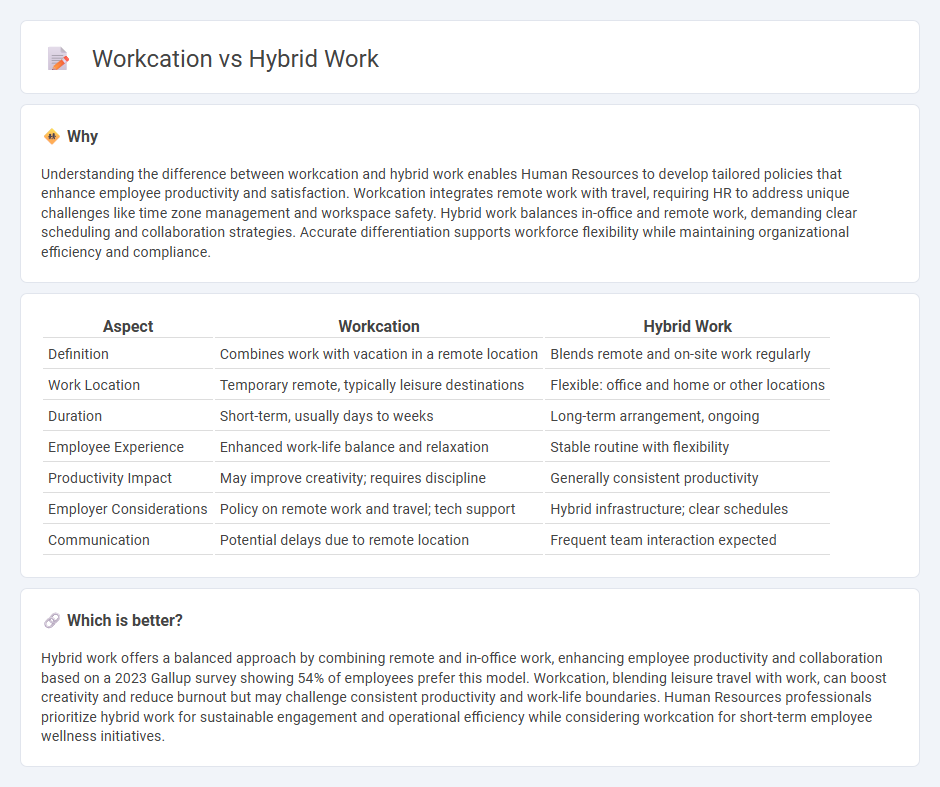
Workcation combines remote work with travel, allowing employees to maintain productivity while exploring new environments, often leading to enhanced creativity and job satisfaction. Hybrid work models blend remote and in-office days, fostering flexibility and collaboration to improve work-life balance and team dynamics. Explore how these evolving work models can transform your organization's human resources strategy.
Why it is important
Understanding the difference between workcation and hybrid work enables Human Resources to develop tailored policies that enhance employee productivity and satisfaction. Workcation integrates remote work with travel, requiring HR to address unique challenges like time zone management and workspace safety. Hybrid work balances in-office and remote work, demanding clear scheduling and collaboration strategies. Accurate differentiation supports workforce flexibility while maintaining organizational efficiency and compliance.
Comparison Table
| Aspect | Workcation | Hybrid Work |
|---|---|---|
| Definition | Combines work with vacation in a remote location | Blends remote and on-site work regularly |
| Work Location | Temporary remote, typically leisure destinations | Flexible: office and home or other locations |
| Duration | Short-term, usually days to weeks | Long-term arrangement, ongoing |
| Employee Experience | Enhanced work-life balance and relaxation | Stable routine with flexibility |
| Productivity Impact | May improve creativity; requires discipline | Generally consistent productivity |
| Employer Considerations | Policy on remote work and travel; tech support | Hybrid infrastructure; clear schedules |
| Communication | Potential delays due to remote location | Frequent team interaction expected |
Which is better?
Hybrid work offers a balanced approach by combining remote and in-office work, enhancing employee productivity and collaboration based on a 2023 Gallup survey showing 54% of employees prefer this model. Workcation, blending leisure travel with work, can boost creativity and reduce burnout but may challenge consistent productivity and work-life boundaries. Human Resources professionals prioritize hybrid work for sustainable engagement and operational efficiency while considering workcation for short-term employee wellness initiatives.
Connection
Workcation and hybrid work both prioritize flexibility and employee well-being by blending remote work with occasional office presence. Hybrid work models enable employees to split time between home and office, while workcations extend this flexibility by allowing work from vacation-like settings, enhancing productivity and job satisfaction. Organizations adopting these approaches often see improved talent retention and increased engagement through accommodating diverse work preferences.
Key Terms
Flexibility
Hybrid work offers employees the flexibility to split time between remote and office settings, optimizing productivity and work-life balance. Workcations blend leisure and work, allowing professionals to perform job duties from vacation destinations, enhancing creativity and reducing burnout. Explore how these flexible work models can transform your professional lifestyle.
Productivity
Hybrid work balances remote and in-office tasks, enhancing productivity through structured flexibility and minimized commuting stress. Workcation blends work and leisure in a new environment, which can boost creativity but may challenge focus due to distractions. Discover more about optimizing productivity in diverse work models.
Employee Engagement
Hybrid work models enhance employee engagement by offering flexibility between remote and in-office settings, fostering collaboration and work-life balance. Workcations combine work responsibilities with leisure travel, promoting creativity and reducing burnout through new environments. Explore the impact of hybrid work and workcation strategies to optimize employee engagement in your organization.
Source and External Links
What is hybrid work and what are hybrid work models? - Webex - Hybrid work is a flexible model blending in-office, remote, and on-the-go work, offering employees autonomy to choose where they are most productive, with various hybrid models depending on organizational needs.
The Rise of Hybrid Work: Redesigning Work-Life Balance - Hybrid work gained prominence post-pandemic as a sustainable model combining remote and in-office work, improving productivity, flexibility, and work-life balance while influencing office design and real estate strategies.
What Is Hybrid Work? - Cisco - Hybrid work, accelerated by the pandemic, is widely recognized for benefits including increased flexibility, productivity, cost savings, and sustainability by enabling employees to mix remote and in-office work.
 dowidth.com
dowidth.com